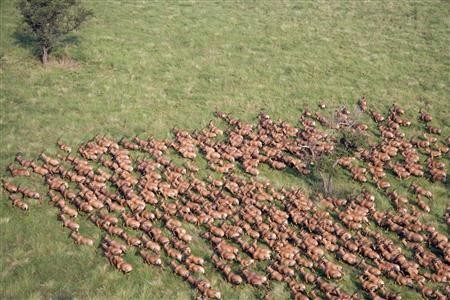Tooth Enamel Reveals the Transformation of Ancient Herding in Africa
| Marco Foronda | | Mar 11, 2015 08:53 AM EDT |
(Photo : Reuters/Paul Elkan and J. Michael Fay/National Geographic/ Wildlife Conservation Society) A tiang herd in Boma National Park in Southern Sudan.
A University of Utah study of nearly 2,000 year-old livestock teeth show early herders from northern Africa could have traveled past Kenya's Lake Victoria on their way to southern Africa because the area was grassy and not tsetse fly infested bushland as previously believed.
One hypothesis is that deteriorating climate and less favorable rainfall over the last 10,000 years pushed herding technology across Africa.
Like Us on Facebook
People domesticated their own flocks since they were no longer able to rely for food on natural resources, such as wild animals and fish. But one archaeological site bucked this trend: Gogo Falls in southwest Kenya, close to Lake Victoria.
The site was occupied by people between 1,900 and 1,600 years ago that also hunted and fished for nearly half of their resources rather than relying almost entirely on livestock.
The chemical signature of their teeth revealed they must have been eating so much grass in the Lake Victoria Basin on their way to the Southern Africa, according to author Kendra Chritz, paleo-ecologist and University of Utah doctoral student in biology who pioneered the study on wild antelopes and domesticated animals like cows, goats and sheep.
"That means Lake Victoria could have been an area through which people passed while migrating southward to southern Africa. It was thought that Lake Victoria wasn't part of the route because of a natural barrier - namely, a cool, moist, bushy environment filled with tsetse flies that would have infected humans and livestock with African sleeping sickness, which can be fatal," adds Chritz.
This can easily be explained through the simple understanding of how herders spread through Africa. It's the aspect of food production that's changed the way of living for many people. Researchers study the issue because the transition to herding livestock from hunting, fishing and gathering transformed human populations.
The study published in the journal Proceedings of the National Academy of Sciences was sponsored by the National Science Foundation, Geological Society of America with the main player being a student researcher in chemistry and anthrobiology M. Esperanza Zagal.
TagsHerds, Tooth Enamel Transformation Ancient Herding Africa, herding, Africa, tooth enamel, livestock teeth, herder, antelopes, cows, goats, sheep, Lake Victoria
©2015 Chinatopix All rights reserved. Do not reproduce without permission
EDITOR'S PICKS
-

Did the Trump administration just announce plans for a trade war with ‘hostile’ China and Russia?
-

US Senate passes Taiwan travel bill slammed by China
-

As Yan Sihong’s family grieves, here are other Chinese students who went missing abroad. Some have never been found
-

Beijing blasts Western critics who ‘smear China’ with the term sharp power
-

China Envoy Seeks to Defuse Tensions With U.S. as a Trade War Brews
-

Singapore's Deputy PM Provides Bitcoin Vote of Confidence Amid China's Blanket Bans
-

China warns investors over risks in overseas virtual currency trading
-

Chinese government most trustworthy: survey
-

Kashima Antlers On Course For Back-To-Back Titles
MOST POPULAR
LATEST NEWS
Zhou Yongkang: China's Former Security Chief Sentenced to Life in Prison

China's former Chief of the Ministry of Public Security, Zhou Yongkang, has been given a life sentence after he was found guilty of abusing his office, bribery and deliberately ... Full Article
TRENDING STORY

China Pork Prices Expected to Stabilize As The Supplies Recover

Elephone P9000 Smartphone is now on Sale on Amazon India

There's a Big Chance Cliffhangers Won't Still Be Resolved When Grey's Anatomy Season 13 Returns

Supreme Court Ruled on Samsung vs Apple Dispute for Patent Infringement

Microsoft Surface Pro 5 Rumors and Release Date: What is the Latest?










